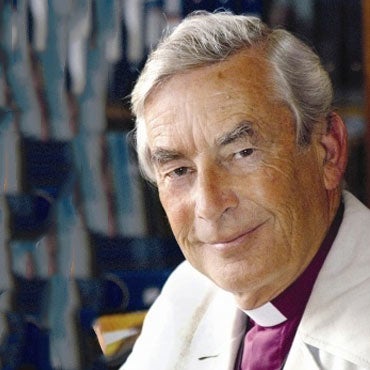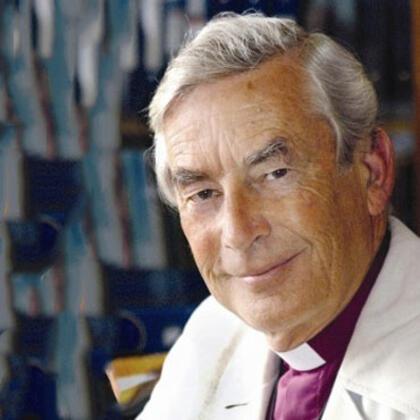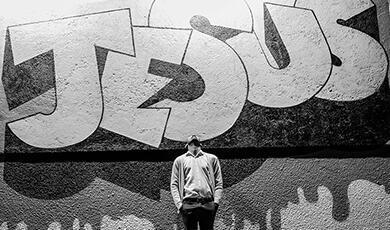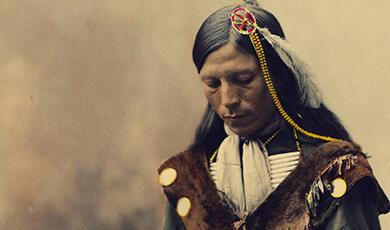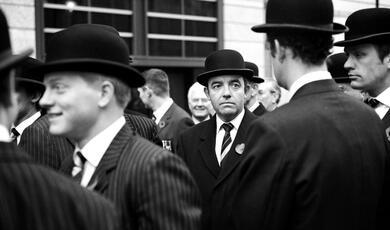Christian Themes in Art: The Nativity in Art
Share
- Details
- Transcript
- Audio
- Downloads
- Extra Reading
This is one of the richest themes in art, showing an amazing development of associated ideas and images right up to the 21st century.
This is a part of the 2010/2011 series of Divinity lectures by Lord Harries. For other lectures in this series, please follow this link: Christian Themes in Art
Download Transcript
Christian Themes in Art: The Nativity in Art
Lord Harries
Epiphany (January 6th), originally the important feast. Earliest mention of December 25th only in 336. That was date of feast of temple of Sol Invictus in Rome, the unconquerable sun, chief deity for Roman emperors in 4th c. Dec 17th feast of Saturnus with feasting, presents and reversal of roles.
Funeral plaque to Severa, 330.
Under streets of Rome; a noble lady in Catacomb of Priscilla (now in Vatican Museum of early Christian art). Basket seat for Mary. Magi, astrologers (REB), wise men, (RSV) Joseph pointing to star, from story of Balaam.
'I see him, but not now;
I behold him, but not near;
A star will come forth out of Jacob,
A comet will arise from Israel. (Numbers 24, 17)
Magic of ancient world at feet of Christ.
Fresco in catacomb of Sts Mark and Marcellian, 4th c.
Parallel of fresco of trial of three young men in Daniel, also in Persian dress.
St Maria Maggiore, 5th c.
Child Jesus on throne, kings on either side. Tradition still open and experimental
Council of Ephesus, 431, title of theotokos. Now three king like figures.
Santa Prassede, adoration of the three kings
Rebuilt and decorated by Pope Paschal in 822.
Note the different ages
4th century sarcophagus.
Phrygian caps. Large star. Note animals.
Pilgrim Flask, 6th c. from Palestine
Helena located holy sites in 4th century-pilgrimages began. Take back souvenirs, ampullae with oil. Full frontal, imperial imagery, star a sign of divinity. Kings on one side, shepherds on the other.
7th or 8th Century Palestinian Ivory.
Ivory survives. Note the less classical style away from Constantinople-angular. Full frontal, regal, on top half kings and an angel.
Bottom half. Mary on pallet, Joseph pointing to a star. The animals. The crib like an altarof sacrifice. Midwife, Salome, who doubted virgin birth holding up withered hand. Protoevangelium of James. (2nd century)
St Apollinare Nuovo
Wonderful 6th century mosaics. Basilica style building. Processions of virgins and martyrs. Green colour of paradise, palm trees, flowers.All is verdant and fruitful. The figures are king like and of different ages.
Procession of virgins
3 Magi
Mary as empress
Story of 3 Magi in Matthew. Mazdeans, Zoroastrian priests from Persia. Why three? It mentions three gifts, gold, frankincense and myrrh. How come kings? Influence of psalms and Isaiah, thought to prophecy coming of Christ.e.g. Psalm 68, 'Because of the temple of Jerusalem shall kings bring presents unto thee.' From the East-but tradition came to see them from all over. Psalm 72, kings of Sheba and Sala shall bring gifts. Isaiah, foretells the gentiles coming, bearing gold and frankincense coming by camel, which may have suggested both Arabia and Africa. Called Kings and given names from 3rd century (In West Caspar, Melchior and Balthazar), but only common from 6th. In art Kings not depicted until 10th. From 9th century they represented 3 races, Africa, Asia and Europe and 3 ages of man In the West, Caspar, Melchior and Balthazar. Relics taken from Constantinople via Milan to Cologne where there is a fine religquary.
Icon of Nativity
Russian icon by follower of Rubliev, 14th century. Standard iconography then and now. Composite scene. Mountain, with creation renewed. Note size of Mary, on red (royal) pallet (travelling bed). Exhausted because Christ was truly human, born of a woman.
Angels bowing before babe.
No mention of cave in biblical account. 2nd century tradition. In Bethlehem today you are shown a cave. Plato's image of humans as being in a cave seeing only shadows of reality. Christ, the truly real, comes into our darkness. Crib like an altar, with ox and ass.
Midwives
No mention of midwives in Biblical account. From Protoevangelium of James . Their function to ensure that Mary was virgo intacta .One doubted, her hand was withered then cured. Here simply washing the babe. Iconography based on birth of Dionysius (Bachus), mosaic in Paphos, and in Beirut. Took over classical, royal iconography.
Joseph
Joseph tempted to doubt the virgin birth-not part of central group, as not the father. In some icons old bent shepherd has horns
Squinches, frescos, icons, mosaics
Greece, Hosios Loukas, 1020
Daphni, 1100
11th century, iconography settled, note ray from star
Cyprus, Lagoudera, completed in 1192
In Church of Panagia tou arakou (The pea-like so many appellations of Virgin from plants or vegetables). In Troodos mountains, exterior hidden, inside a heaven. Classical revivals in Constantinople-Macedonian, Comnenian and Palaelogian emperors. A high point of of Byzantine art in middle period, 9th-12th centuries. Note classical features, beautiful midwife, handsome shepherd, exquisite angel. Metropolitan art that went over the empire. Joseph consoled by a donkey, crib an altar.Sheep standing still. Mary dominant on white pallet. All aesthetically pleasing.
12th century Sicily, Palermo.
Coming together of East and West, Eastern workmen and iconography but style more Western.
Russian Icon.
So what about the West?
Franks casket, 8th c
Whalebone, with riddle, in BM.
'The fish beat up the seas on to the mountainous cliff, the king of terror became sad when he swam onto the shingle.' 'whalebone, reminder of Jonah and resurrection.
The animals
The Winchester Bible, 13th century. Animals from 4th century. Why animals? No mention in Gospels. Isaiah 1,3
The ox knows its owner,
And the donkey its master's crib;
but Israel does not know,
my people do not understand.
Referred to by commentators from 2nd century, and in mind of Luke who three times refers to the crib. The shepherds are a sign that this verse has been repealed, some of God's people do recognise their owner. Later developed an anti-Jewish note-the ox and ass recognise their owner but Jews still did not.
Francis had a crib at midnight mass at Christmas 1223-after which crib scene became popular. New, intense spirituality: imagine you are there.
Chartres Cathedral,
12th century carving on rood loft. Joseph with blanket, the animals at either end keeping Christ child warm
Ludolf of Saxony's Vita Christi writer claimed to see how 'the ox and the ass kneeling down, put their mouths to the crib, breathing through their noses on to the Christ child, because they knew at that cold time he needed to be heated up in this manner.'
Fine carving of the middle ages
The three kings, from Chartres
Human and animated. Christ delighted, Mary smiling, the kings enjoying themselves, the angel very interested.
An angel comes to the three kings in a dream. Autun, 12th c
Warning them not to go back home via Herod. Giselbertus. One of the very few works that have a name.
Early Renaissance carving
Nativity scene, on pulpit in Baptistery of Pisa Cathedral, Nicola Pisano.
Adoration of three kings, on pulpit
Traditional scene, Mary large and on a pallet, the midwives etc. But classical style. Mary could have come from a Roman statue of a matron. Sense of life and vibrancy.Renaissance sculpture in Italy really begins with the Pisanos, father Nicola,(c.1220-1284) and son Giovanni(1245-1314).
Giotto, Scrovegni Chapel, (1266-1337)
The Nativity
Adoration of the three kings
Cimabue thought he held the field,
in painting, and now Giotto is the cry,
the other's fame is obscured. (Dante)
Not only did the young boy equal the style of his master, but he became such an imitator of nature that he completely banished that crude Greek style and revived the modern and excellent art of painting, introducing good drawing from live natural models, something which had not been done for more than two hundred years. (Vasari)
Byzantium art dominated Italy at the time. Vasari wrong in describing it as crude. A sophisticated art which follows certain spiritual conventions. Giotto retains a Byzantine sense of devotion and reverence whilst combing it with more naturalism. By the high renaissance, whatever the glories of the paintings as paintings, something of that other dimension has been lost?
Note camel looking at Christ, whilst retainer looks up at Camel. Off centre scene, tender reverence. Human emotion, classical lines, and sense of devotion.
The High Renaissance-Northern Europe
Rogier van der Wyden, 1400-46
Bladelin Altar, Berlin
Bridget of Sweden had a vision of the nativity whilst in the church in Bethlehem, her Revelations widely known by 1400 and influenced Northern artists. Mary shown taking off her blue mantle and shawl, kneeling on the ground in a white tunic adoring the naked Christ. He lies on the ground emitting light-the luminous child outshines the light of Joseph's lantern.
Nativity, Hugo van der Goes, 1440-82/3
Flemish, entered a monastry. Spirit of devotion, looking down at the babe.
The Nativity, at Night, Geertgen tot Sint Jans, 1490, in National Gallery.
A lay brother in the order of St John in Haarlem. A sense of stillness, quiet devotion, solemn reverence. Innocent goodness. The light coming from the Christ child.
Rembrandt, Nativity, 1606-69
Dark cavernous stable with the family huddled round the light of Christ. Only in 15th and 16th century do shepherds get depicted in their own right. Appealed to Rembrandt. In early life painted in grandiose style, then a series of tragedies, deaths of three children and wife, and bankruptcy; painted with a sense of pity for suffering mortals.-a working stable, ropes and ladders around. Ordinary faces of shepherds chatting, boy with a dog. Not traditional ox and ass but a cow. Heaven in ordinary.
Gerrit van Honthorst, 1590-1656
The adoration of the Shepherds
Dutch painter of Biblical and genre scenes much influenced for part of his life by Caravaggio and the use of chiascuro
Print of the Adoration.
14th and 15th centuries.What was originally public art became an art for private devotion. Then printing made this private devotional more widely available
The High Renaissance-Italy
Gozzoli, the procession of the kings to Bethlehem.
On wall in Medici Palace in Florence, 1459/60. Opportunity to show famous people of the time, including Byzantines who came for the Council of Florence in 1438/9. Luxury, ostentation, all coming to worship.
Damaskinos, 1530/5-1592/3
From Crete, a centre of painting after fall of Constantinople. Under Venetian rule. Damaskinos highly regarded and invited to paint in Venice. Orthodox iconography-mountains and angels with Western details, such as elaborate procession.
Piero della Fransesca, 1415-75
Not many pictures, but all striking. Florence in the background. Unfinished? Run down stable, symbolizing the end of Judaism. Northern influence, child on ground-with flowers growing- and ordinary animals.
Singers, perhaps influenced by Luca della Robbia.
Mantagna, 1431-1506
The adoration of the magi
Warm rich colours, contrasting translucent white of Christ child. Lived in Padua, sculptural style influenced by Donatello, clear line. Revival of classical world Close up-three kings, white, brown and black, old middle aged and young. Hints one being black earlier but thirty Ethiopian ambassadors went to Rome and Avignon in 1306. They were there at council of Florence in 1439. Idea took hold in Germany then in Italy with Mategna
Sandro Botticelli, 1447-1515
The Mystic Nativity, the National Gallery
Angels above and below. Dance and embrace. Influenced by Platonism and Savonarola.Joachim of Fiore (died 1202) taught that there were three ages or dispensations on earth, that of the Father, that of the Son and that of the Holy Spirit. That third age was dawning with the advent of the new religious orders, who would convert the world and usher in the end of the world. Although Joachim's views were condemned by the papacy they were highly influential, particularly amongst the Fransicans and kept on recurring in the centuries afterwards, including at this time, for the end was expected in 1503. Time of Savoranola who turns Florence upside down. Count Piero della Mirandolla said he was so terrified of Savanorola's sermons that they made his hair stand on end and people shouted out at the end of them 'Mercy and long live Jesus Christ our King.'
Botticelli heard some of the sermons and was clearly troubled by them. Some of his family were piagnoni or whiners, the name given to followers of Savonarola, and his later paintings seem to reflect an apocalyptic mood like this one. Heaven and earth embrace-divine music and divine dance. Olive crowns and palms, devils scurry into holes. Medieval symbolism, e.g. size of child
Greek text at top referring to the woes predicted in Book of Revelation, indicate a belief in second coming predicted to occur soon. Troubled time politically, France had invaded Italy,
Edward Burne Jones, 1833-98
The Adoration, in Castle Museum in Norwich
Many materials in Christian art, including tapestries: 5th century Egypt, loved by middle ages-revived in 19th century-late Romanticism, Gothic Revival, all things from middle ages. Reaction to industrialisation-but can touch us. Mary in bower of flowers in rustic gazebo, paradise, lilies, one of the kings a knight, Joseph a peasant. Going to be ordained, but turned towards art as a result of William Morris and Dante Gabriel Rossetti. Part of later stage of Pre-Raphaelites, Dante Gabriel Rossetti, Holman Hunt, Millais. Best known for wonderful stained glass.
Eric Gill, 1882-1940
Lettering of the beginning of Chapter 2, St Matthew's Gospel.
From 5th century initial letters of book turned into a picture-wonderful mediaeval examples. Revived by Gill. Began as a letter cutter-sculptor, engraver and writer, as well as typographer. 1913, became a catholic-stations of the cross in Westminster Cathedral, and Prospero and Ariel for Broadcasting House. Religious guild for craftsmen.
Elegance, grace, balletic beauty
Mark Cazalet, b.1944
The Three Kings
Jesus, arms out in form of Christ, Mary looking anxious, three kings worried.
Nicholas Mynheer, b. 1958
The Nativity
Beryl Cook, 1926-2008
Nativity Scene, 1990
One of Britains most popular artists. Large, cheerful, self-confident woman, though she herself was shy. Lived in Plymouth all her life. Had no formal training, did not start until middle aged. Influenced by Stanley Spencer and Edmund Burra. 'Rubens with jokes'. (Victoria Wood). Like a child's farm set. Exuberant delight.
Yasuo Ueno, 1926
A multitude of the heavenly host
Professor at Tamma art college in Tokyo. Angels play a major part in nativity story-to shepherds in the field 'And suddenly there was with the angel a multitude of the heavenly host praising god and saying, 'Glory to God in the highest, and peace on earth and good will toward men.'
Norman Adams, 1927-2005
The Nativity
For some the greatest of modern painters depicting Christian themes, particularly his stations of the cross in Manchester.
Nativity with burning bush
When he was Principal Lecturer at St Martin's School of Art in the 1960s and '70s, Herbert for a time gave up painting in a representational way, repressing his drive to make images that tell stories. Finding abstraction too restrictive, he eventually found a way back to figurative painting through looking at children's art and making primitive, illustrative, figurative etchings. Had no early religious education or interest in it, but was received in the Roman Catholic church in 1958. Over his last five decades Herbert consistently painted surprising and dream-like images that are the product of an unusual, highly individual imagination. His seemingly naïve yet sophisticated paintings were the result of his life-long journey exploring 'what lies beneath the surface of the mind'. He was on a life-long search for 'the marvellous' which began with a youthful encounter with Surrealism. Recognised as an artist with a powerful and original poetic vision. Mary, stepping out of the burning bush, in the heart of the darkness of God offers Christ to the old man humbly kneeling
John Piper, 1903-1992
Stained glass in St Mary's, Iffley, Oxford
His Ppintings of churches well known. A good number of windows. On Oxford DAC. Legend that all animals became articulate on Christmas Day, and there was a Mass in which the choristers took parts of different animals. Prudentius (c4th) wrote a poem on the theme and a 17th century carol has the words
The cock croweth: 'Christus natus est (Christ is born)
The raven asked 'Quando' (when?)?
The crow replied 'Hoc nocte (this night)'
The ox cried out 'Ubi' Ubi' ( where, where?)'
The sheep bleated out 'Bethlem. Bethlem.'
A voice from heaven sounded:'Gloria in excelsis
Glory be on high
Whilst armies of angels sang: 'Alleluia!
Salutaton and glory and honour and power be to the Lord our God!'
Part of:
This event was on Wed, 08 Dec 2010
Support Gresham
Gresham College has offered an outstanding education to the public free of charge for over 400 years. Today, Gresham plays an important role in fostering a love of learning and a greater understanding of ourselves and the world around us. Your donation will help to widen our reach and to broaden our audience, allowing more people to benefit from a high-quality education from some of the brightest minds.


 Login
Login
